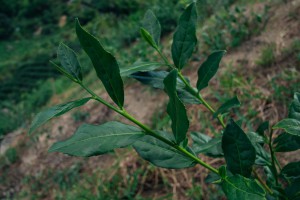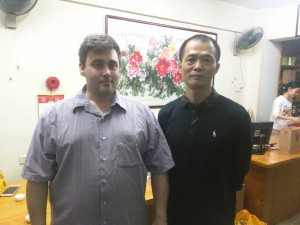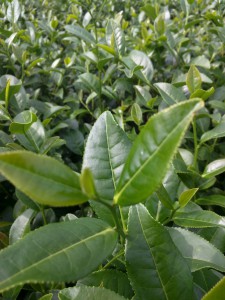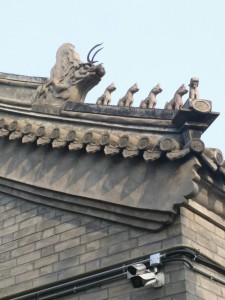My first foray into the world of Chinese tea really started with Tieguanyin.
Under advisement from my mother, who had seen lovely advertising for a yoga hostel in Xiamen, Fujian, I set out to the South Eastern tip of China in search of a nice vacation away from my job at the time, which was as custodian of a particularly rowdy gaggle of Canadian university students. In Xiamen, I went to explore the local tea markets, which had always interested me. The first year in China, before the year under discussion, I had visited the Shanghai tea market many times, and also began to experiment with Japanese green teas during my many months spend travelling in that country.
I liked tea, but you would have been hard pressed to call it a passion at that time.
When I went to xiamen, things changed a lot, as I was exposed to the tremendous abundance of different varieties of Tieguanyin tea. I had known beforehand that tea in China was graded into quality levels, but nothing really can prepare one for Tieguanyin, which is such a tremendously diverse tea, not only in production method, but also in range of tastes and smells that this unusual Oolong leaf can make.
The first time I was in Xiamen, I must have purchased about twenty different samples from various tea stores, each one totally different.
It was that year that I met my tea teacher, He Caitong, a very patient and sophisticated Taiwanese woman in Shanghai who taught me a great deal about the nature of Chinese and Taiwanese teas. One thing she said to me was that her feeling about Tieguanyin was that it was a problem cultivar and she did not enjoy drinking it, since it made her feel cold.
During this time, while learning about what real Taiwanese tea was under teacher He, I also travelled to Xiamen several times in search of tea, and then later to Quanzhou and the surrounding tea fields and porcelain districts in the area.
I think the first tea farm that I ever visited was Long Jing, but the first tea farm I tried to understand was in Fujian and it produced Mao Xie Oolong, a sister of Tieguanyin.
One thing that particularly stuck out to me at that time was the farmer there, old man Zhang, had a special stash of half finished tieguanyin that he kept in a freezer.
The half finished tea was a green Tieguanyin style tea that was lightly curled, but had not been baked or finished in post production. He had to keep it in the fridge because it would go bad within a few days otherwise.
This was my first inkling that something special was up with the Tieguanyin scene in South Fujian.
One day, my teacher gave me a box of Tieguanyin that she said had won an award in Anxi. She said that this particular tea was as close to traditional Tieguanyin as was still available in China and that I should go home and compare it against what I had tried before. Tasting the tea, I could understand why it is called “Iron” goddess of mercy. The perfume of the tea was of deep orchid flowers, the bake was heavy but not burnt, and there was a strong, cold, steely aftertaste which was delicious and stayed in my mouth and throat for hours after. I believed at the time that I had finally tasted the “real” Chinese Tieguanyin.
Not long after, on a trip to Taiwan, I met with tea farmer Zhang Mingfeng, who runs the Zishan tea garden at Muzha in Taipei. His family is one of the oldest producers of Tieguanyin on the mountain and are originally from Anxi China, having gone to Taiwan four generations ago to plant tea for the British. Zhang spoke well of Wuyi tea, which he felt was the real traditional Oolong in China, but explained that he was not a fan of Chinese Tieguanyin, preferring his family’s own deeply baked and oxidized variant of the famous tea. I began a long, beneficial relationship with him and his farm and have had a chance to try and to retail most of the teas he grows at some time or other in my store.
Certainly Taiwanese Tieguanyin is excellent tea and much better than the average Chinese version of comparable price.
Last December, I went back to Xiamen, at the request of a family friend, and was introduced to multiple tea hobbiests there who tasted the local teas with me and helped me contextualize the Tieguanyin cultivar much more carefully.
It turns out that one of the reasons that we don’t see so much heavily baked Tieguanyin in Fujian anymore is because there is a prevailing opinion that the highest rung of Tieguanyin leaves are to be processed in such a way that they are not brought into completion of post production through a deep firing process. This means that the highest grades of Tieguanyin in the area are very green in nature, and must be kept in a refrigeration or else they will spoil and lose their flavour and perfume.
Having said that, there are also many types of Tieguanyin in Fujian which are not often seen outside of the area, and I was very surprised to find a “Mi Xiang” honey scent Tieguanyin grown in Anxi, which was very similar to the Taiwanese one I sell at my store.
I remarked to the person giving me the tea that I would not know how to buy this particular tea and he said “of course you wouldn’t, they wouldn’t be willing to sell it to you,” it seems that there is much more to learn about tieguanyin and that my journey is far from over.
I also discovered that there are a few people in Xiamen who still make Tieguanyin in the old fashioned way, and I was lucky enough to meet old Mr.Chen, an ex sports coach who’s love for baking tea was so great that he quit his job and opened up a coal firing house in Anxi to make baked tea each spring. One big difference between Anxi and Taiwan Tieguanyin is that in Taiwan, the best baked tea is made in the winter, while in Anxi, it is only made in the spring, since there is a prevalent local belief that tea baked in the fall will come out tasting bad (that isn’t to say that tea isn’t baked in the fall, but that there are many people who do not approve of this practice).
I also had the good luck in 2016 to meet the owners of a local shop in Hong Kong who still produce old fashioned Tieguanyin in their own way at their facilities there. The tea is sent down half finished to their store and they do the post production with the old Shifu there, whose tea knowledge was passed down through the generations to him via his ancestors.

My tea journey thus far has been really splendid, and I’ve had a chance to drink many different teas, visit many different growing regions, and come to understand the Oolong field, especially in Taiwan quite well, but there is one tea, my first big interest, Tieguanyin which seems to be like an endlessly deep pool of water. I look into the translucent yellow, or red, or brown liquid, sweet perfume rising in the steam, and I’m transported somewhere, on the side of a mountain in the fresh air. I look out forever into the distance and the sky has no final junction, it is just an expanse of colour and mystery. The tea in my cup is also a mystery because every time I think I’ve perceived its bottom, it simply changes and becomes deeper, and more elusive.
January 17
2017




